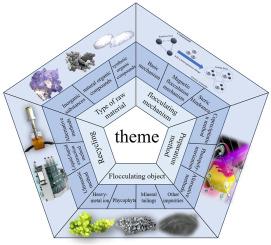Preparation and application of composite magnetic flocculants for wastewater treatment: A review
IF 8.4
2区 环境科学与生态学
Q1 ENVIRONMENTAL SCIENCES
引用次数: 0
Abstract
Wastewater treatment plays a vital role in protecting natural environments. Among the various wastewater treatment methods, flocculation achieves effective wastewater treatment, owing to its high efficiency, convenience, and cost-effectiveness. Compared to traditional flocculants, Composite magnetic flocculants have attracted significant attention due to their distinctive "core-shell" structure, magnetic flocculation mechanism and high efficiency recovery. This promotes sustainable development in wastewater treatment, highlighting the significant prospects for its application and potential advancement. This review begins by discussing the raw materials and treatment methods of composite magnetic flocculants and presenting common materials and associated preparation techniques. By combining the advantages of organic and inorganic components, disparate raw materials give flocculants different properties and flocculation efficiency. Through the comprehensive analysis of the flocculation mechanism, the flocculation efficiency of various wastewater treatment targets was elucidated, and the exceptional performance in overcoming steric hindrance was introduced. Subsequently, recycling approaches were summarized to determine the advantages and disadvantages in terms of recovery efficiency, operational difficulty, and impact on particle structure. Based on the current developmental status, this review provides a prospective outlook on future exploration trends in composite magnetic flocculants, valuable references, and theoretical foundations for related research and engineering practices.

复合磁性絮凝剂的制备及其在污水处理中的应用综述
废水处理在保护自然环境中起着至关重要的作用。在各种污水处理方法中,絮凝处理以其高效、便捷、经济等优点,达到了有效的污水处理效果。与传统絮凝剂相比,复合磁性絮凝剂因其独特的“核-壳”结构、磁性絮凝机理和高效回收而备受关注。这促进了废水处理的可持续发展,突出了其重要的应用前景和潜在的进步。综述了复合磁性絮凝剂的原料和处理方法,介绍了常用的磁性絮凝剂材料及其制备技术。不同的原料结合有机和无机组分的优势,使絮凝剂具有不同的性能和絮凝效果。通过对絮凝机理的综合分析,阐明了不同废水处理目标的絮凝效果,并介绍了其克服位阻的优异性能。随后,总结了各种回收方法,从回收效率、操作难度、对颗粒结构的影响等方面确定了各自的优缺点。本文从目前的发展现状出发,对复合磁性絮凝剂的未来发展趋势进行了展望,为相关研究和工程实践提供了有价值的参考和理论基础。
本文章由计算机程序翻译,如有差异,请以英文原文为准。
求助全文
约1分钟内获得全文
求助全文
来源期刊

Journal of Environmental Management
环境科学-环境科学
CiteScore
13.70
自引率
5.70%
发文量
2477
审稿时长
84 days
期刊介绍:
The Journal of Environmental Management is a journal for the publication of peer reviewed, original research for all aspects of management and the managed use of the environment, both natural and man-made.Critical review articles are also welcome; submission of these is strongly encouraged.
 求助内容:
求助内容: 应助结果提醒方式:
应助结果提醒方式:


